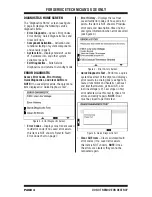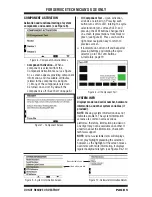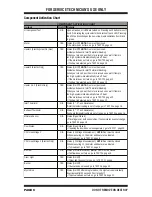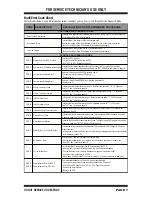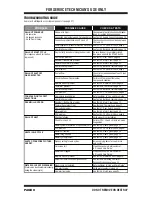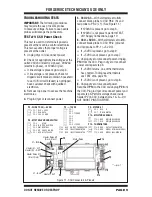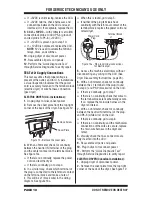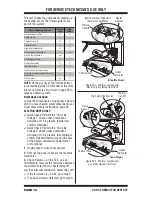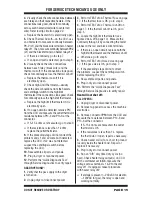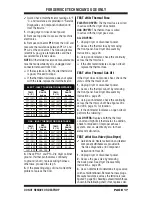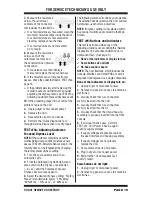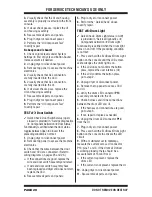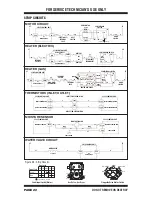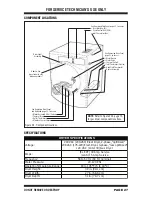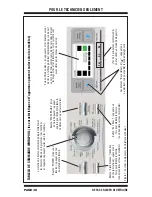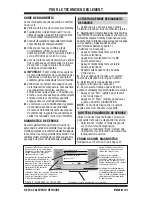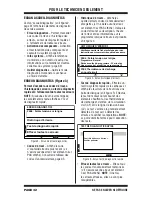
PAGE 17
FOR SERVICE TECHNICIAN’S USE ONLY
DO NOT REMOVE OR DES
TROY
3
Quick Check: Inlet thermistor readings in °F,
°C, and resistance are provided in “Service
Diagnostics
➔
Component Activation
➔
Inlet Thermistor.”
1. Unplug dryer or disconnect power.
2. Remove top panel to access the machine
electronics.
3. Remove connector P14 from the CCU and
measure the resistance between P14-1 and
P14-2 at the connector. The following tables
(electric & gas) give temperatures and their
associated resistance values.
NOTE: All thermistor resistance measurements
must be made while dryer is unplugged and
connector removed from CCU.
If the resistance is OK, the inlet thermistor
is good. Proceed to step 4.
If the thermistor resistance does not agree
with the table, replace the inlet thermistor.
4. Check P14-1 and P14-2 to dryer cabinet
ground. If either pin indicates continuity
to ground (short), replace wiring harness;
otherwise, proceed to step 5.
5. If the preceding steps did not correct the
problem, replace the CCU.
TEMP.
°F (°C)
RES.
RANGE
k ohms
TEMP.
°F (°C)
RES.
RANGE
k ohms
68° (20°)
61.2–63.7
131° (55°)
14.5–15.3
77° (25°)
49.0–51.0
140° (60°)
12.1–12.8
86° (30°)
39.5–41.1
149° (65°)
10.2–10.7
95° (35°)
32.0–33.3
158° (70°)
8.5–9.0
104° (40°)
26.1–27.2
167° (75°)
7.2–7.6
113° (45°)
21.4–22.3
176° (80°)
6.1–6.5
122° (50°)
17.6–18.5
ELECT - INLET THERMISTOR RESISTANCE
TEMP.
°F (°C)
RES.
RANGE
k ohms
TEMP.
°F (°C)
RES.
RANGE
k ohms
68° (20°)
57.5–67.6
131° (55°)
14.1–15.6
77° (25°)
46.1–53.8
140° (60°)
11.8–12.9
86° (30°)
37.4–43.1
149° (65°)
9.9–10.8
95° (35°)
30.4–34.7
158° (70°)
8.4–9.0
104° (40°)
24.9–28.2
167° (75°)
7.1–7.6
113° (45°)
20.5–23.0
176° (80°)
6.0–6.4
122° (50°)
16.9–18.9
GAS - INLET THERMISTOR RESISTANCE
TEST #4b: Thermal Fuse
ELECTRIC DRYER: The thermal fuse is wired
in series with the dryer drive motor.
GAS DRYER: The thermal fuse is wired
in series with the dryer gas valve.
ALL DRYERS:
1. Unplug dryer or disconnect power.
2. Access the thermal fuse by removing
the front panel. See Dryer Disassembly
Instructions, page 23.
3. Using an ohmmeter, check the continuity
across the thermal fuse.
If the ohmmeter indicates an open circuit,
replace the thermal fuse.
TEST #4c: Thermal Cut-Off
If the dryer does not produce heat, check the
status of the thermal cut-off.
1. Unplug dryer or disconnect power.
2. Access the thermal cut-off by removing
the front panel. See Dryer Disassembly
Instructions, page 23.
3. Using an ohmmeter, check the continuity
across the thermal cut-off. See figures 20a
and 20b, page 14, for location.
4. If the ohmmeter indicates an open circuit,
perform the following:
ALL DRYERS: Replace both the thermal
cut-off and high limit thermostat. In addition,
check for blocked or improper exhaust
system, and, on electric dryers, for heat
element malfunction.
TEST #4d: Gas Valve (Gas Dryer)
3
Quick Check: Heater activation and related
component attributes are provided in
“Service Diagnostics
➔
Component
Activation
➔
Heat On.”
1. Unplug dryer or disconnect power.
2. Access the gas valve by removing
the back panel. See Dryer Disassembly
Instructions, page 23.
3. Use an ohmmeter to determine if a gas valve
coil has malfunctioned. Remove harness plugs.
Measure resistance across the terminals (see
figure 21, page 18). Readings should match those
shown in the following chart; if not, replace coils.


